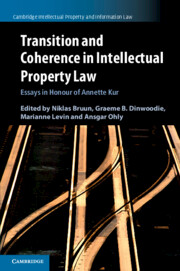Book contents
- Transition and Coherence in Intellectual Property Law
- Cambridge Intellectual Property and Information Law
- Transition and Coherence in Intellectual Property Law
- Copyright page
- Contents
- Preface
- Greetings to Annette Kur from the Second Floor
- Annette Kur: Toward Understanding
- Part I Transition
- A Forms and Institutions
- B International Commitments and Constraints
- C New Agents and the Challenge of New Technologies
- 12 Transition through Automation
- 13 Eye, Robot: Artificial Intelligence and Trade Mark Registers
- 14 Patent Protection of Inventions Involving Artificial Intelligence
- 15 Automated Profiling in New Media and Entertainment Markets: What to Protect, and How?
- Part II Coherence
- Conclusion
- Cambridge Intellectual Property and Information Law
13 - Eye, Robot: Artificial Intelligence and Trade Mark Registers
from C - New Agents and the Challenge of New Technologies
Published online by Cambridge University Press: 29 December 2020
- Transition and Coherence in Intellectual Property Law
- Cambridge Intellectual Property and Information Law
- Transition and Coherence in Intellectual Property Law
- Copyright page
- Contents
- Preface
- Greetings to Annette Kur from the Second Floor
- Annette Kur: Toward Understanding
- Part I Transition
- A Forms and Institutions
- B International Commitments and Constraints
- C New Agents and the Challenge of New Technologies
- 12 Transition through Automation
- 13 Eye, Robot: Artificial Intelligence and Trade Mark Registers
- 14 Patent Protection of Inventions Involving Artificial Intelligence
- 15 Automated Profiling in New Media and Entertainment Markets: What to Protect, and How?
- Part II Coherence
- Conclusion
- Cambridge Intellectual Property and Information Law
Summary
The edifice of trade mark registration exists primarily to provide useful information. Registers tell us who owns what. They signal the existence of exclusive property rights associated with commercial signs, thereby allowing other traders to plan around that information. These signals exist in ever increasing numbers. According to the World Intellectual Property Organization (WIPO), an estimated 9.11 million new trade mark applications were filed worldwide in 2017, while in the same year there were an estimated 43.2 million active trade mark registrations at 138 offices worldwide.2 Until recently, it was axiomatic that registers for marks were directed at human readers – an applicant for a trade mark, trade mark registry examiners, vigilant competitors, employees of search and watching agencies as well as the occasional judge. This list now has a new entrant. What are the implications for the registered trade mark ecosystem, when algorithms begin to efficiently and comprehensively read trade mark registers?
- Type
- Chapter
- Information
- Transition and Coherence in Intellectual Property LawEssays in Honour of Annette Kur, pp. 174 - 190Publisher: Cambridge University PressPrint publication year: 2021
- 2
- Cited by

